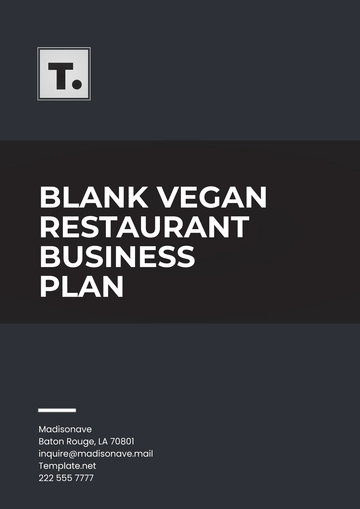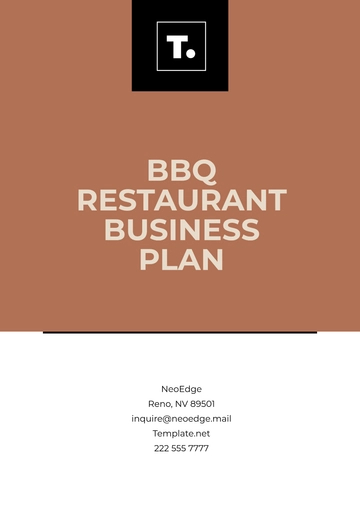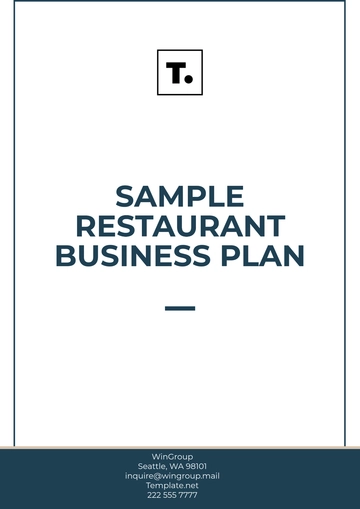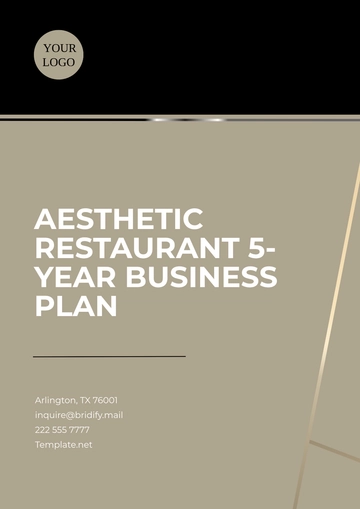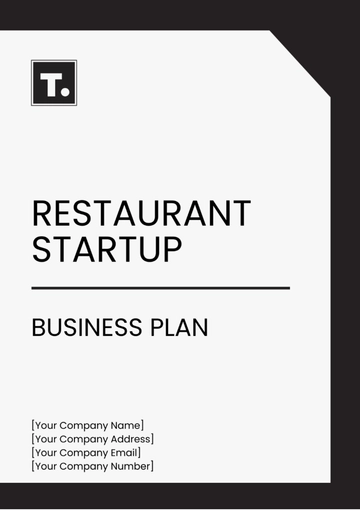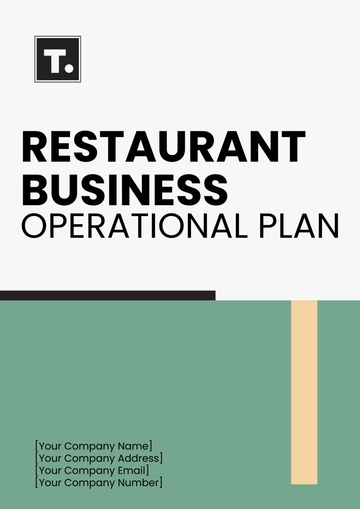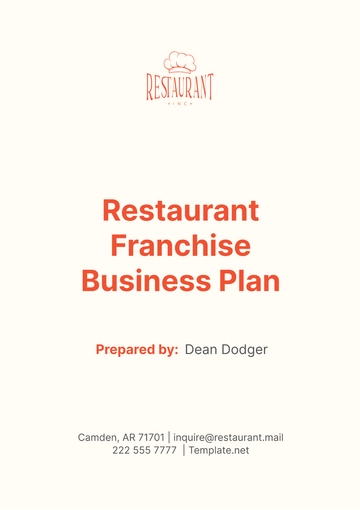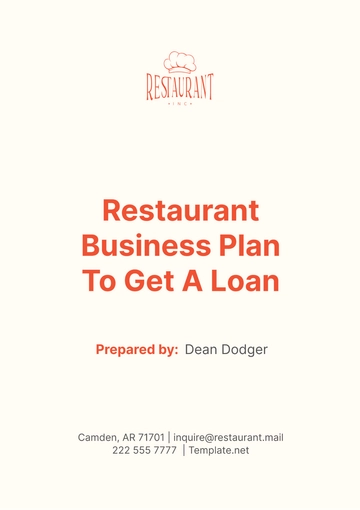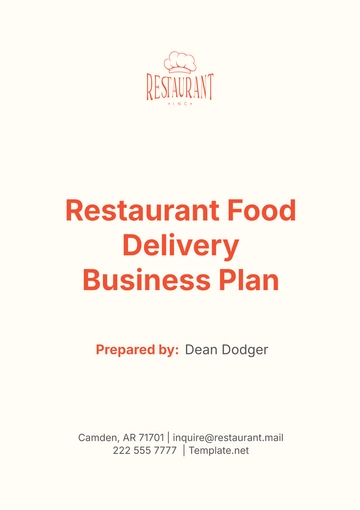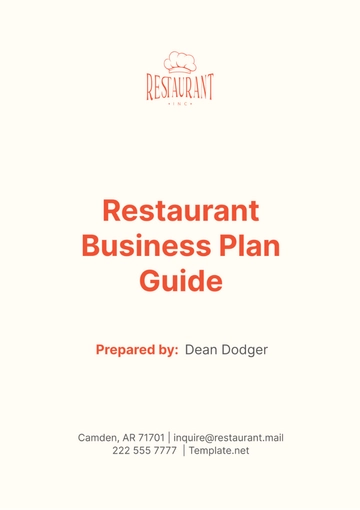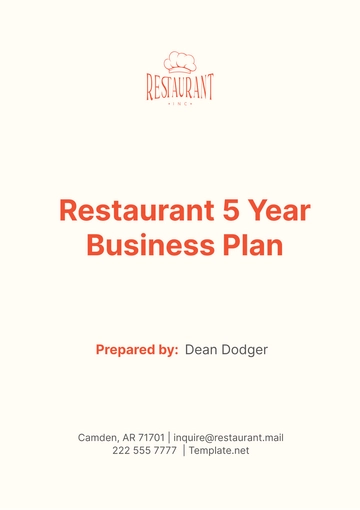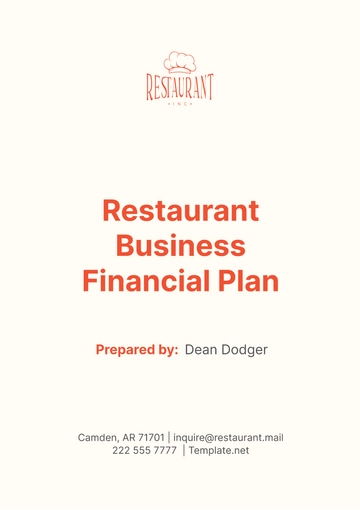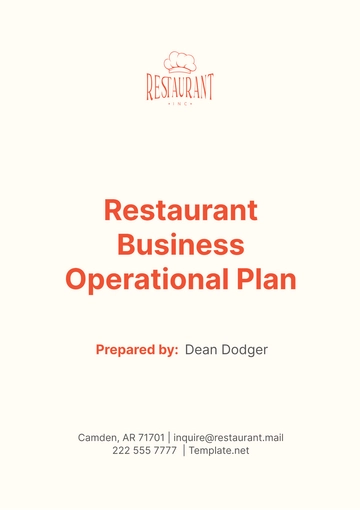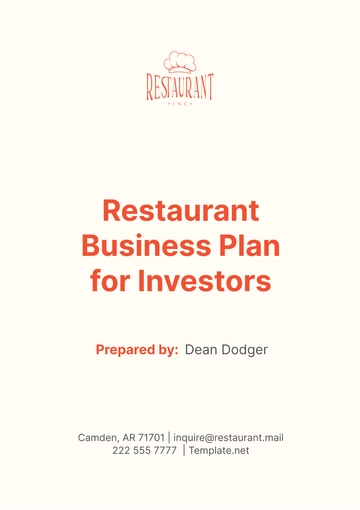Free Restaurant 5 Year Business Plan
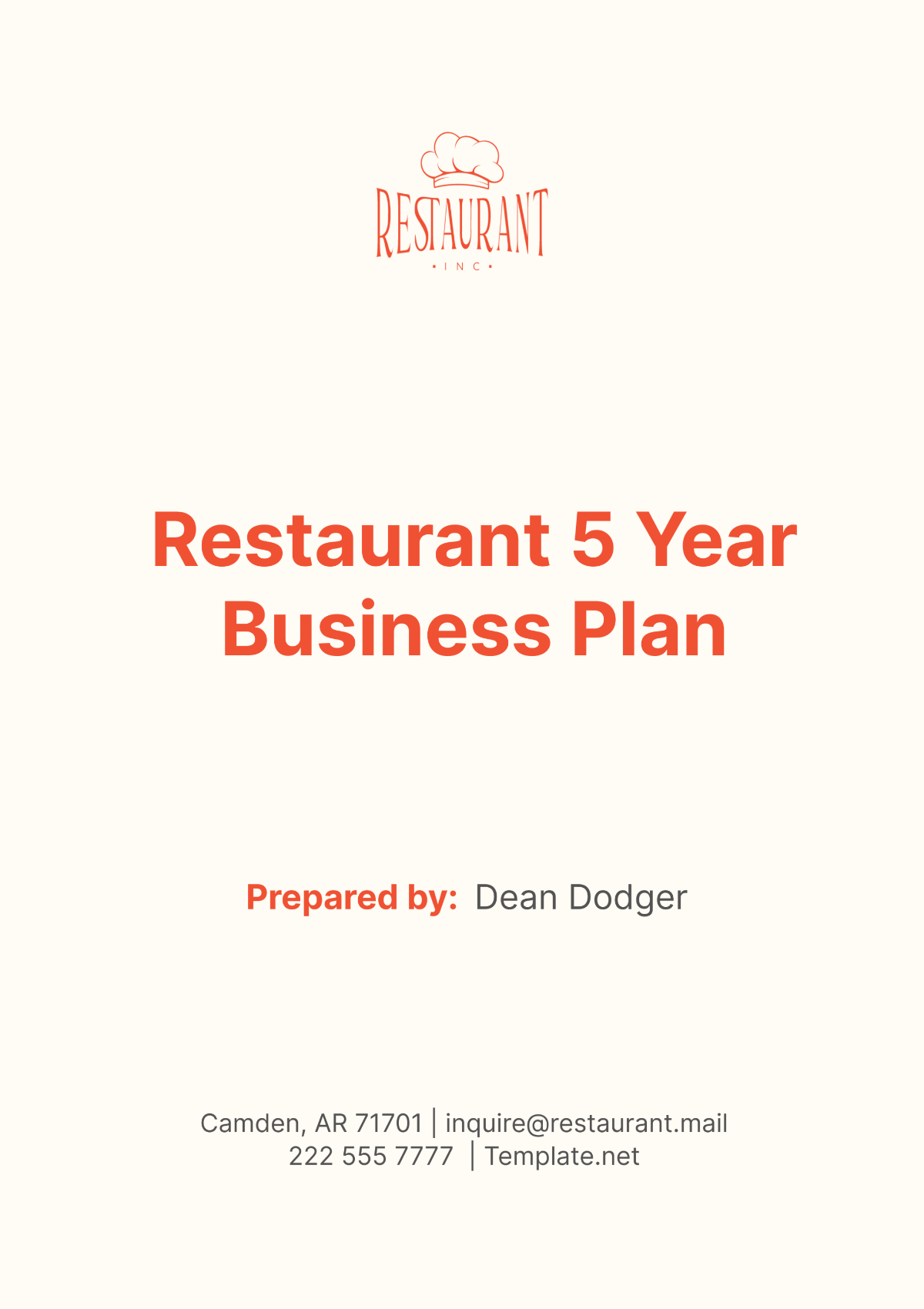
I. Executive Summary
[Your Company Name] is committed to robust growth and enhanced market penetration with a strategic plan to elevate our restaurant's financial and operational performance over the next five years. Our goal is to achieve a minimum of 25% growth in annual revenue by expanding our customer base and significantly improving customer satisfaction. This growth will be supported by introducing culturally diverse menu offerings that align with current health trends and consumer demands, ensuring that each dish not only satisfies but also intrigues our customers. Advanced digital marketing strategies will be employed to amplify our brand presence, targeting specific demographics with precision and creatively engaging with potential and existing customers through multiple online platforms.
Our strategic initiatives include a comprehensive overhaul of our operational processes and the environment in which our staff and customers interact. Upgrades to kitchen equipment and technology will enable us to streamline operations and enhance the quality of service. Staff training programs will be intensified, focusing on excellence in customer service, culinary skills, and operational efficiency. These changes are expected to reduce overhead costs, decrease waste, and improve the overall dining experience, making [Your Company Name] a preferred destination for diverse culinary adventures.
To measure our success and refine our strategies, we will employ a detailed analytics approach. We will track key performance indicators (KPIs) such as customer footfall, average ticket size, table turnover rate, and customer satisfaction scores. This data will help us adjust our marketing strategies, menu design, and customer service practices to better meet the needs of our patrons and maximize profitability. The table below provides an overview of our projected financial and operational metrics over the next five years:
Year | Projected Revenue Increase | Customer Footfall | Table Turnover Rate | Average Ticket Size | Customer Satisfaction Score |
|---|---|---|---|---|---|
Year 1 | 5% | 150 daily | 3 times per day | $30 | 85% |
Year 2 | 10% | 175 daily | 3.5 times per day | $35 | 88% |
Year 3 | 15% | 200 daily | 4 times per day | $40 | 90% |
Year 4 | 20% | 225 daily | 4.5 times per day | $45 | 92% |
Year 5 | 25% | 250 daily | 5 times per day | $50 | 95% |
II. Market Analysis
Understanding the dynamic landscape of the restaurant industry is vital for the strategic positioning of [Your Company Name]. Our market analysis will delve deep into current and emerging trends, consumer behaviors, and the competitive environment to ensure we are not just participants but leaders in the industry. This involves identifying niche markets that are underserved and demographic shifts that could potentially open new avenues for growth. By analyzing consumer preferences for healthy and culturally diverse foods, we can tailor our menu to meet these expectations, thus setting us apart from the competition. Additionally, we will examine the market penetration strategies of leading competitors, which will help us craft innovative offerings that are not only unique but also more appealing to our target demographic.
The next phase of our analysis focuses on identifying potential partnerships that can enhance our visibility and operational capabilities. This includes local suppliers who align with our commitment to freshness and sustainability, technology partners who can enhance our digital presence, and community organizations that can help us reach more consumers. We will explore emerging markets, particularly those that are becoming more health-conscious and culturally diverse, as they present opportunities for expansion and increased market share. Our findings will influence not only our menu design but also our marketing strategies, ensuring they are culturally sensitive and aligned with contemporary dietary trends.
The culmination of our market analysis will be a robust strategic plan that incorporates detailed consumer insights and competitive intelligence. We will track metrics such as market growth rates, customer acquisition costs, and the effectiveness of different marketing channels. These insights will be pivotal in refining our marketing strategies and service offerings to ensure optimal alignment with market demands. The table below summarizes key market analysis metrics and targets over the next five years:
Year | Market Growth Rate | Customer Acquisition Cost | Marketing Channel Effectiveness | Niche Market Penetration |
|---|---|---|---|---|
Year 1 | 4% | $120 | 75% | 10% |
Year 2 | 6% | $115 | 80% | 20% |
Year 3 | 8% | $110 | 85% | 30% |
Year 4 | 10% | $105 | 90% | 40% |
Year 5 | 12% | $100 | 95% | 50% |
These initiatives and metrics will guide [Your Company Name] in navigating the complexities of the restaurant industry, enabling us to continuously innovate and cater effectively to our customers' evolving tastes and preferences.
III. Product and Service Development
At [Your Company Name], our commitment to innovation is demonstrated through the continuous evolution of our menu offerings. By introducing a range of culturally diverse dishes that cater to various dietary preferences—from gluten-free to vegan options—we address the growing consumer demand for personalized dining experiences. This development process is highly collaborative, involving our talented chefs, nutrition experts, and market analysts to ensure that each new dish not only meets but exceeds the culinary expectations of our patrons while adhering to sustainability principles. We prioritize sourcing local, organic ingredients to support local farmers and minimize our environmental impact, thereby enhancing the overall quality and freshness of our meals.
In parallel to our menu innovations, we are dedicated to elevating our service standards to provide an exceptional dining experience. This includes comprehensive training programs for all staff, focusing on customer service excellence and operational efficiency. We will integrate the latest technology to streamline ordering and payment processes, making dining more convenient for our customers. Digital menus and tableside ordering systems will be implemented to allow for immediate feedback and interaction, which will not only speed up service but also enhance customer satisfaction by accommodating their preferences in real-time.
To ensure that these improvements are effectively implemented and meet our high standards, we will establish rigorous monitoring and evaluation systems. Regular training updates, feedback sessions, and performance reviews will be conducted to maintain service excellence. Additionally, we will measure the success of our new menu items through customer feedback, sales data, and periodic reviews, adjusting our offerings as necessary to better suit customer tastes and market trends. The table below outlines our expected milestones for product and service development over the next five years:
Year | New Menu Items Introduced | Local Ingredients Sourced | Staff Training Sessions | Technology Integration Level |
|---|---|---|---|---|
Year 1 | 10 | 40% | 4 quarterly | Basic |
Year 2 | 15 | 50% | 6 quarterly | Intermediate |
Year 3 | 20 | 60% | 8 quarterly | Advanced |
Year 4 | 25 | 70% | 10 quarterly | Full |
Year 5 | 30 | 80% | 12 quarterly | Fully Integrated |
Through these targeted initiatives, [Your Company Name] will not only adapt to industry trends but set new standards for culinary excellence and customer service in the restaurant industry.
V. Marketing Strategy
At [Your Company Name], our approach to marketing is as innovative and dynamic as our dining experience. We are set to deploy a multi-channel digital marketing strategy designed to amplify our brand visibility and foster deep engagement with our target audience. By harnessing the power of social media platforms, we will engage customers through regular updates, live events, and interactive content that showcases our new menu items and the cultural stories behind them. Email marketing will be utilized to keep our loyal customers informed about upcoming events and promotions, encouraging repeat visits and sustained interest. Our website will also play a crucial role, serving as a central hub for reservations, menu explorations, and the latest news about our culinary adventures.
To ensure our marketing efforts are both timely and relevant, we will develop a comprehensive content calendar that is meticulously aligned with major culinary events and cultural festivities throughout the year. This strategy will not only enhance our community involvement but also attract new customers looking for unique dining experiences. Special promotions, themed events, and limited-time offers will be strategically placed to capitalize on these peak times, driving both foot traffic and online engagement. By creating a buzz around these events, we aim to position [Your Company Name] as a cultural epicenter in the culinary world.
Furthermore, our marketing strategy will be underpinned by robust data analytics to maximize the effectiveness of our campaigns. We will employ advanced tools to track the performance of our advertising efforts, gather customer feedback, and analyze engagement metrics. This data-driven approach will allow us to fine-tune our strategies in real-time, optimizing our reach and impact across all channels. The table below outlines key metrics and targets for our marketing strategy over the next five years:
Year | Social Media Engagement | Email Campaign Open Rate | Website Traffic | Promotional Events Hosted |
|---|---|---|---|---|
Year 1 | 25% increase | 20% | 10,000 visits | 4 |
Year 2 | 35% increase | 25% | 20,000 visits | 6 |
Year 3 | 45% increase | 30% | 30,000 visits | 8 |
Year 4 | 55% increase | 35% | 40,000 visits | 10 |
Year 5 | 65% increase | 40% | 50,000 visits | 12 |
Through strategic planning and execution, [Your Company Name] will enhance its market presence, connect with a broader audience, and continuously improve the effectiveness of its marketing initiatives to secure a dominant position in the market.
V. Operational Plan and Management
At [Your Company Name], our focus on operational excellence is pivotal to our strategy for growth and efficiency. We are committed to upgrading our kitchen facilities with state-of-the-art technology, which will significantly enhance our food preparation processes and minimize waste. Investment in high-efficiency appliances and the design of an ergonomic workspace are critical steps that will reduce operational costs and boost productivity. These improvements will not only benefit our staff with a better work environment but will also enhance the quality and speed of service, meeting customer expectations for quick and delightful dining experiences.
To complement our technological upgrades, we will implement a comprehensive management training program aimed at cultivating leadership and operational efficiency among our team leaders. This initiative will equip our managers with the skills necessary for effective decision-making and problem-solving, which are essential in a fast-paced restaurant environment. We will also introduce regular reviews and operational audits to ensure adherence to industry best practices and to identify areas for improvement. This continuous feedback loop will help maintain high standards in every aspect of our operations, from customer service to inventory management.
Our operational plan includes detailed milestones for the rollout of technology upgrades and training programs. We will closely monitor the implementation process to ensure each phase aligns with our overall business objectives and contributes to a seamless operational flow. The table below outlines the key operational targets and timelines over the next five years:
Year | Technology Upgrades | Staff Productivity Increase | Management Training Sessions | Operational Audits Conducted |
|---|---|---|---|---|
Year 1 | 20% of kitchen upgraded | 10% increase | 2 | 1 quarterly |
Year 2 | 40% of kitchen upgraded | 20% increase | 4 | 2 quarterly |
Year 3 | 60% of kitchen upgraded | 30% increase | 6 | 3 quarterly |
Year 4 | 80% of kitchen upgraded | 40% increase | 8 | 4 quarterly |
Year 5 | 100% of kitchen upgraded | 50% increase | 10 | 4 quarterly |
Through these targeted improvements and regular evaluations, [Your Company Name] aims to establish a benchmark in operational excellence, ensuring every aspect of our restaurant operations contributes positively to our goals for sustainable growth and exceptional customer service.
VI. Financial Projections and Strategy
Our financial strategy at [Your Company Name] is meticulously structured to support sustained growth and increased profitability over the next five years. We have developed a detailed budget that carefully allocates resources for significant capital investments, such as state-of-the-art kitchen upgrades and dynamic marketing campaigns. These investments are projected to drive increased revenue by attracting a larger customer base and enhancing the dining experience, thereby encouraging repeat business and positive word-of-mouth. Our revenue projections are grounded in a thorough analysis of market trends and our planned expansions in service offerings and geographic reach.
To manage costs effectively, [Your Company Name] will implement a robust cost management system that focuses on monitoring and controlling operational expenses. This will include optimizing staff schedules to align labor costs with service demand, thereby avoiding overstaffing during slower periods and ensuring adequate coverage during peak times. Additionally, we will leverage advanced data analytics to forecast sales trends, which will enable precise inventory management, reducing waste and the costs associated with over-purchasing. These strategic initiatives are designed to streamline operations and maximize financial performance.
Our financial strategy also includes regular financial reviews to assess the effectiveness of our spending and identify opportunities for further cost reductions or necessary adjustments in investment. The table below provides an overview of our financial targets, including projected revenue growth and cost management milestones:
Year | Projected Revenue Growth | Capital Investments | Cost Savings Initiatives | Financial Review Frequency |
|---|---|---|---|---|
Year 1 | 10% | $500,000 | Staff scheduling optimization | Bi-annually |
Year 2 | 15% | $300,000 | Advanced inventory management | Bi-annually |
Year 3 | 20% | $200,000 | Data-driven sales forecasting | Annually |
Year 4 | 25% | $100,000 | Enhanced cost control measures | Annually |
Year 5 | 30% | Minimal | Continuous improvement processes | Annually |
Through disciplined financial planning and proactive management of resources, [Your Company Name] aims to not only meet but exceed our financial targets, ensuring the long-term success and sustainability of our business.
- 100% Customizable, free editor
- Access 1 Million+ Templates, photo’s & graphics
- Download or share as a template
- Click and replace photos, graphics, text, backgrounds
- Resize, crop, AI write & more
- Access advanced editor
Discover the Restaurant 5 Year Business Plan Template at Template.net. Professionally designed, this editable and customizable template is streamlined for efficiency, easily editable in our Ai Editor Tool. Ensure a solid business foundation with a comprehensive plan that adapts to your vision and market changes. Start shaping your restaurant’s future today and turn your culinary dreams into practical plans with Template.net.
You may also like
- One Page Business Plan
- Coffee Shop Business Plan
- Restaurant Business Plan
- Food Business Plan
- Real Estate Business Plan
- Executive Summary Business Plan
- Cover Page Business Plan
- Nonprofit Business Plan
- Daycare Business Plan
- Construction Business Plan
- Startup Business Plan
- Medical Business Plan
- Bakery Business Plan
- Service Plan
- Hotel Business Plan
- Catering Business Plan
- School Business Plan
- Healthcare Business Plan
- Transportation Plan
- Sports Plan
- Car Wash Business Plan
- Salon Business Plan
- Clothing Business Plan
- Farming Business Plan
- Boutique Plan
